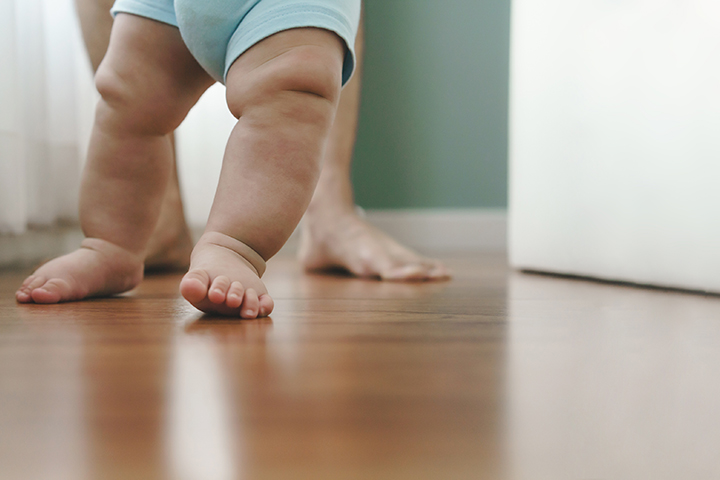Babies with a fleshy roundish appearance look adorable. Besides, these so-called “fat babies” are generally considered healthier than lean and thin babies. However, though the fat gain in babies reflects healthy growth and development, excess fat is not desirable. So how much fat gain in babies is considered excessive? Knowing this is vital as not all babies who look bulky are overweight or obese. Rather, it is normal for most babies to be slightly heavy and plump.
Read on to learn about excess fat in babies, when heavier babies are considered healthy and when they are not, and how parents can prevent their babies from gaining excessive weight.
Are “Fat Babies” Healthy?
According to Richard I. Shader, MD, “most adequately nourished newborns have fat rolls on their legs and arms and noticeably short to absent necks (1).” At birth, about 15 percent of the baby’s weight is fat, which is higher than many mammals.
Therefore, babies naturally tend to have a roundish appearance. Most babies who appear plump or flabby are completely healthy, well-fed and their bulkiness may not necessarily indicate an underlying problem, overweight, or obesity.
During the entire first year, most babies gain weight and may become hefty; however, some may appear fat and some may not, depending on their height.
Functions of baby fat
About 95% of baby fat is subcutaneous white fat or subcutaneous white adipose tissue, while the remaining 5% is brown fat or brown adipose tissue. Body fat, especially brown fat, is necessary for babies to support several body functions, such as the regulation of body temperature through insulation. Baby fat also works as an energy reserve facilitating the baby’s rapid brain growth and development (2).
Why Are Some Babies Heavier Than Others?
The birth weight and subsequent weight gain in babies can depend on several factors (3).
- Genetics: Research shows that parental height and weight can influence the baby’s birth weight and weight gain pattern during infancy(4). Also, women of certain genetic backgrounds may usually give birth to heavier babies.
- Gender: Full-term boys tend to be heavier at birth and gain weight faster than full-term girls. Androgen (a male hormone) activity might be responsible for the occurrence (5).
- Birth order: Evidence suggests that second-born babies are usually heavier than their first-born siblings, although there can be exceptions. Several factors, including changes in gestational age, may cause this weight disparity (6).
- Maternal weight: An overweight or obese pregnant woman could have a higher risk of delivering a heavy baby (7). The baby may also have excess weight gain.
- Maternal health status: Certain maternal health conditions during gestation could lead to a heavier baby at birth. For instance, gestational diabetes may lead to high birth weight and other complications in newborns (8).
- Maternal diet: A woman’s diet during gestation could influence an infant’s birth weight and weight gain pattern. According to a Harvard School of Public Health study, women who consume excessive trans-fat foods, such as fried foods and baked goods, during pregnancy usually give birth to larger babies (9).
- Post-term delivery: Babies born after 42 weeks (post-term) of gestation are likely to be larger than those born full-term (10). Very few babies are born after 42 weeks, and the reasons for the pregnancy to prolong are unclear(11).
- Excessive formula feeding: Overfeeding formula or feeding formula in large bottles could lead to weight gain in formula-fed babies (12).
- Inappropriate solid foods: A baby older than six months consumes various solids and drinks. Feeding the baby high-sugar, processed foods, and drinks, such as fruit juices, could cause excess weight.
Some of the other factors that can influence a baby’s birth weight and weight gain are fetal chromosomal abnormalities and multiple births. The intertwining of multiple factors could result in a specific growth trend, causing some babies to become heavier than others.
What Are The Health Risks Of Excess Weight In Babies?
Several studies note that excess and rapid weight gain during the first two years of life is strongly correlated with overweight and obesity in later life (13) (14). Reports of the National Health and Nutrition Examination Survey show that the prevalence of obesity among children aged two to five years was about 12.7%, in the US. Babies constantly gain weight through infancy and toddlerhood. However, weight gain at a rate faster than normal is what usually indicates that the baby is becoming overweight or obese.
Babies with excess weight may find it difficult to balance their neck and maintain posture. They are also likely to experience developmental delays due to a likely delay in attaining developmental milestones, such as crawling and walking (15).
Most risks of excess weight gain can be mitigated through regular monitoring of the baby’s weight. If you feel your baby is gaining too much weight, do not hesitate to talk to a pediatrician.
How To Know If The Baby’s Weight Is A Cause For Concern?
The average birth weight of a full-term, healthy baby can be between 5.5lb (2.5kg) and 10lb (4.5kg) (16). The birth weight of most babies doubles by the fourth or sixth month and triples by the 12th month (17). Throughout this time span, a pediatrician will periodically plot your baby’s weight, height, and head size on a standard growth chart to monitor their growth.
A standard growth chart is an assessment tool that compares a baby’s head size, weight-for-length, length-for-age, and weight-for-age against the standard ranges for babies of the same gender and age (18). If a baby’s weight-for-length is greater than the 98th percentile, they are considered large or heavy (19) (20).
Many babies lose weight by the time they become toddlers. However, if baby fat persists or increases, your doctor will monitor the baby more closely and suggest strategies to regulate weight gain.
Note: Use the World Health Organization’s (WHO) growth charts for monitoring the growth rate of babies under two years of age (18).
How To Keep A Baby At A Healthy Weight?
In most cases, baby fat isn’t a concern, yet keeping your infant’s weight within a healthy range is good for optimal long-term health. Below are some tips that may help keep your baby’s weight on track (21) (22).
- Breastfeed your infant more and for a longer time, which may be beyond 12 months. Breastfeeding reduces your infant’s risk of gaining too much weight.
- Give expressed breastmilk to your baby as much as possible if breastfeeding isn’t possible.
- Use smaller bottles to feed your baby as large bottles often lead to overfeeding.
- Do not give a bottle to your baby to self-soothe or fall asleep. Instead, teach babies ways to self-soothe as early as three months of age.
- Avoid adding cereal to thicken the formula unless directed by your pediatrician.
- Follow responsive feeding. Identify your baby’s hunger cues and feed accordingly rather than following a time table.
- Avoid serving processed foods, such as sugary cereals, and beverages, such as packaged juices, to babies. Instead, offer various foods made with fresh fruits, vegetables, grains, pulses, fish, and lean meat.
- Encourage healthy snacking between meals in limited portions. Choose fresh, homemade snacks instead of packaged options, such as biscuits.
- Encourage physical activity in older babies and toddlers by engaging them in active games, such as outdoor games.
- Avoid pacifying babies and toddlers with food. A baby crying doesn’t always mean they are hungry. A baby/toddler cries due to several reasons, such as boredom.
- Avoid food reinforcement in older babies and toddlers. Do not use food as a reward since it may set unhealthy eating habits and lead to overweight and obesity (23).
A round, chubby, and fat appearance are common in babies. Fat plays several vital functions in the normal functioning of their bodies. It is a common misconception that only babies who appear fat, pudgy, or rotund are healthy, but that is not the only parameter. Some babies may appear chubbier than others, and several factors affect them. Babies consistently gain weight through infancy and toddlerhood. A weight gain at a rate faster than usual may need medical attention. Provide your child with healthy and well-balanced meals to ensure healthy weight gain. Do not put your child on a diet plan without a doctor’s consent, as it may cause adverse effects on their growth and development.
Key Pointers
- Most babies have fat rolls on their bodies, which is not unhealthy.
- The fat helps regulate body temperature and aids in brain development.
- Maternal weight, genetics, or excessive formula feeding are common reasons that contribute to some babies being heavier.
- Encouraging physical activity, avoiding food reinforcement, using smaller feeding bottles, and other ways to manage your baby’s weight are discussed below.
This is a short video explaining baby fat and provides tips on nutrition and exercise for a fit and healthy baby.















